Effects of Mean Normal Stress on Strain-Hardening, Strain-Induced Martensite Transformation, and Void-Formation Behaviors in High-Strength TRIP-Aided Steels
Abstract
1. Introduction
2. Materials and Methods
3. Results
3.1. Microstructure and Retained Austenite Characteristics
3.2. Strain-Hardening Behavior
3.2.1. Flow Stress, Mechanical Properties, and Strain Hardening
3.2.2. X-ray Half-Width and Equivalent Plastic Strain Relation
3.3. Strain-Induced Martensite Transformation Behavior
3.4. Void-Formation Behavior
4. Discussion
4.1. Effect of Mean Normal Stress on Strain-Hardening Behavior
- (i)
- The flow stress of the matrix structure;
- (ii)
- Long-range internal stress hardening, which results from the difference in plastic strain between the matrix structure and the second phase (retained austenite, strain-induced martensite, MA phase, etc.) [34];
- (iii)
- Strain-induced transformation hardening, which results from an increase in the strain-induced martensite fraction. The transformation relaxes the localized stress concentration through an expansion strain [35];
- (iv)
- Forest dislocation hardening, which is estimated with the Ashby equation [36].
4.2. Effect of Mean Normal Stress on Strain-Induced Martensite Transformation Behavior
4.3. Effect of Mean Normal Stress on Void-Formation Behavior
5. Conclusions
- (1)
- The highest volume fraction of retained austenite was achieved in the TAM steel, although the mechanical stability was the lowest. The TPF steel had the lowest retained austenite fraction. The mechanical stability of retained austenite was between that of the TAM and TBF steels. The TBF steel possessed a high retained austenite fraction second to that of the TAM steel, with high a mechanical stability due to the refined retained austenite.
- (2)
- A large difference in the − curves for tension, torsion, and compression was shown in the TBF steel, with a large difference in the strain-hardening rate. In the positive mean normal stress state, the TAM and TBF steels had high strain-hardening rates in an early strain range and a large strain range, respectively, which resulted from the large amounts of retained austenite and the matrix structure. The strain-hardening behavior was hardly influenced by zero and negative mean normal stresses in all steels.
- (3)
- The equivalent plastic strain was linearly related to the X-ray half-width in all mean normal stress states, which enabled the estimation of the equivalent stress in press-formed products. In this case, the TAM steel exhibited the lowest HV0 and the largest n-value. On the other hand, TBF showed the largest HV0.
- (4)
- The positive mean normal stress promoted the strain-induced martensitic transformation, especially in the TBF steel, with the high mechanical stability of retained austenite. This was because the positive mean normal stress promoted the expansion strain.
- (5)
- The positive mean normal stress considerably promoted void-formation behavior by developing the expansion stress/strain, especially in the TPF steel. The effect of the mean normal stress on the void formation behavior in the TBF steel was smaller than those in the TPF and TAM steels because of the low strength ratio, fine matrix structure, and high mechanical stability of retained austenite.
Author Contributions
Funding
Institutional Review Board Statement
Informed Consent Statement
Data Availability Statement
Conflicts of Interest
References
- Senuma, T. Physical metallurgy of modern high strength steel sheets. ISIJ Int. 2001, 42, 520–532. [Google Scholar] [CrossRef]
- Rana, R.; Singh, S.B. Automotive Steels—Design, Metallurgy, Processing and Applications; Woodhead Publishing: Cambridge, UK, 2016; pp. 1–469. [Google Scholar]
- Bleck, W.; Guo, X.; Ma, Y. The TRIP effect and its application in cold formable sheet steel. Steel Res. Int. 2017, 88, 1700218. [Google Scholar] [CrossRef]
- Krizan, D.; Steineder, K.; Kaar, S.; Hebesberger, T. Development of third generation advanced high strength steels for automotive applications. In Proceedings of the 19th International Scientific Conference Transfer 2018, Trencin, Slovakia, 22–23 November 2018; pp. 1–15. [Google Scholar]
- Sugimoto, K.; Kobayashi, M.; Nagasaka, A.; Hashimoto, S. Warm stretch-formability of TRIP-aided dual-phase sheet steels. ISIJ Int. 1995, 35, 1407–1414. [Google Scholar] [CrossRef]
- Sugimoto, K. Fracture strength and toughness of ultra high strength TRIP aided steels. Mater. Sci. Technol. 2009, 25, 1108–1117. [Google Scholar] [CrossRef]
- Sugimoto, K.; Kanda, A.; Kikuchi, R.; Hashimoto, S.; Kashima, T.; Ikeda, S. Ductility and formability of newly developed high strength low alloy TRIP-aided sheet steels with annealed martensite matrix. ISIJ Int. 2002, 42, 910–915. [Google Scholar] [CrossRef]
- Hiwatashi, S.; Takahashi, M.; Katayama, T.; Usuda, M. Effect of deformation-induced transformation on deep drawability—Forming mechanism of TRIP type high-strength steel sheet. J. Jpn. Soc. Technol. Plast. 1994, 35, 1109–1114. [Google Scholar]
- Takahashi, M. Development of high strength steels for automobiles. Nippon. Steel Tech. Rep. 2003, 88, 2–7. [Google Scholar]
- Polatids, E.; Haidemenopoulos, G.N.; Krizan, D.; Aravas, N.; Panzner, T.; Šmíd, M.; Papadioti, I.; Casati, N.; Van Petegem, S. Experimental investigation and modelling the transformation kinetics. Mater. Sci. Eng. A 2021, 800, 140321. [Google Scholar] [CrossRef]
- Sugimoto, K.; Misu, M.; Kobayashi, M.; Shirasawa, H. Effects of second phase morphology on retained austenite morphology and tensile properties in a TRIP-aided dual-phase steel sheet. ISIJ Int. 1993, 33, 775–782. [Google Scholar] [CrossRef]
- Fan, D.; Fonstein, N.; Jun, H. Effect of microstructure on tensile properties and cut0edge formability of DP, TRIP, Q&T and Q&P steels. AIST Trans. 2016, 13, 180–186. [Google Scholar]
- Barnwal, V.K.; Lee, S.; Yoon, S.; Kim, J.; Barlat, F. Fracture characteristics of advanced high strength steels during hole expansion test. Int. J. Fract. 2020, 224, 217–233. [Google Scholar] [CrossRef]
- Matsumura, O.; Sakuma, Y.; Ishii, Y.; Zhao, J. Effect of retained austenite on formability of high strength sheet steels. ISIJ Int. 1992, 32, 1110–1116. [Google Scholar] [CrossRef]
- Rana, R.; Chen, S.; Haldar, A.; Das, S. Mechanical properties of a bainitic steel producible by hot rolling. Arch. Metall. Mater. 2017, 62, 2331–2338. [Google Scholar] [CrossRef]
- Toji, Y.; Nakagaito, T.; Matsuda, H.; Hasegawa, K.; Kaneko, S. Effect of microstructure on mechanical properties of quenching and portioning steel. ISIJ Int. 2023, 63, 758–765. [Google Scholar] [CrossRef]
- Kim, J.; Kwon, M.; Lee, J.; Lee, S.; Lee, K.; Suh, D. Influence of isothermal treatment prior to initial quenching of Q&P process on microstructure and mechanical properties of medium Mn steel. ISIJ Int. 2021, 61, 518–526. [Google Scholar]
- Weiβensteiner, I.; Suppan, C.; Hebesberger, T.; Winkelhofer, F.; Clemens, H.; Maier-Kiener, V. Effect of morphological differences on the cold formability of an isothermally heat-treated advance high-strength steel. JOM 2018, 70, 1567–1575. [Google Scholar] [CrossRef]
- Tang, S.; Lan, H.; Liu, Z.; Wang, G. Enhancement of balance in strength, ductility and stretch flangeability by two-step aus tempering in a 1000 MPa grade cold rolled bainitic steel. Metals 2021, 11, 96. [Google Scholar] [CrossRef]
- Huyghe, P.; Dépinoy, S.; Caruso, M.; Mercier, D.; Georges, C.; Malet, L.; Godet, S. On the effect of Q&P processing on the stretch-flange-formability of 0.2C ultra-high strength steel sheets. ISIJ Int. 2018, 58, 1341–1350. [Google Scholar]
- Im, Y.; Kim, E.; Song, T.; Lee, J.; Suh, D. Tensile properties and stretch-flangeability of TRIP steels produced by quenching and partitioning (Q&P) process with different fractions of constituent phases. ISIJ Int. 2021, 61, 572–581. [Google Scholar]
- Kim, J.; Seo, E.; Kwon, M.; Kang, S.; De Coomn, B.C. Effect of quenching temperature on stretch flangeability of a medium Mn steel processed by quenching and partitioning. Mater. Sci. Eng. A 2018, 729, 276–284. [Google Scholar] [CrossRef]
- Chang, Y.; Han, S.; Li, X.; Wang, C.; Zheng, G.; Dong, H. Effect of shearing clearance on formability of the third generation automotive medium-Mn steel with metastable austenite. J. Mater. Process. Technol. 2018, 259, 216–227. [Google Scholar] [CrossRef]
- Maruyama, H. X-ray measurement of retained austenite. Jpn. Soc. Heat Treat. 1977, 17, 198–204. [Google Scholar]
- Dyson, D.J.; Holmes, B. Effect of alloying additions on the lattice parameter of austenite. J. Iron Steel Inst. 1970, 208, 469–474. [Google Scholar]
- Cullity, B.D. Elements of X-ray Diffraction, 2nd ed.; Addison-Wesley Publishing Company, Inc.: Boston, MA, USA, 1978; p. 287. [Google Scholar]
- Takebayashi, S.; Kunieda, T.; Yoshinaga, N.; Ushioda, K.; Ogata, S. Comparison of the dislocation density in martensitic steels evaluated by some X-ray diffraction methods. ISIJ Int. 2010, 50, 875–882. [Google Scholar] [CrossRef]
- Hill, R. The Mathematical Theory of Plasticity; Oxford University Press: New York, NY, USA, 1985; p. 20. [Google Scholar]
- Bridgman, P.W. Studies in Large Plastic Flow and Fracture; McGraw Hill: New York, NY, USA, 1952; pp. 9–37. [Google Scholar]
- Sugimoto, K.; Sakaguchi, J.; Iida, T.; Kashima, T. Stretch-flangeability of a high-strength TRIP type bainitic steel. ISIJ Int. 2000, 40, 920–926. [Google Scholar] [CrossRef]
- Williamson, G.K.; Hall, W.H. X-ray line broadening from filed aluminum and wolfram. Acta Metall. 1953, 1, 22–31. [Google Scholar] [CrossRef]
- Kawata, H.; Yasutomi, T.; Shirakami, S.; Nakamura, K.; Sakurada, E. Deformation-induced martensite transformation behavior during tensile and compressive deformation in low-alloy TRIP steel sheets. ISIJ Int. 2021, 61, 527–536. [Google Scholar] [CrossRef]
- Castanheira, B.C.; Moreira, L.P.; do Nacimento, G.O.; Santos, R.O.; de Avila Santiago, G.A.; de Oliveira, I.S.; da Silva, F.R.F. Void formation and strain-induced martensite transformation in TRIP780 steel sheet submitted to uniaxial tensile loading. Mater. Res. 2019, 22 (Suppl. S1), e20190245. [Google Scholar] [CrossRef]
- Mura, T.; Mori, T. Micromechanics; Baifukan Co., Ltd.: Tokyo, Japan, 1976; p. 23. [Google Scholar]
- Sakaki, T.; Sugimoto, K.; Fukuzato, T. Role of internal stress for continuous yielding of dual-phase steels. Acta Metall. 1983, 31, 1737–1746. [Google Scholar] [CrossRef]
- Ashby, M.F. Work hardening of dispersion-hardened crystals. Philos. Mag. 1966, 14, 1157–1178. [Google Scholar] [CrossRef]
- Azuma, M.; Goutianos, S.; Hansen, N.; Winther, G.; Huang, X. Effect of hardness of martensite and ferrite on void formation in dual phase steel. Mater. Sci. Technol. 2012, 28, 1092–1100. [Google Scholar] [CrossRef]
- Shoji, H.; Hino, K.; Ohta, M.; Shinohara, Y.; Minami, F. Ductile fracture mechanism for dual phase steel with high strength second phase. Trans. Jpn. Weld. Soc. 2015, 33, 341–348. [Google Scholar] [CrossRef]
- Archie, F.; Li, X.; Zaefferer, S. Micro-damage initiation in ferrite-martensite microstructures: A statistical characterization of crystallographic and chemical parameters. Mater. Sci. Eng. A 2017, 701, 302–313. [Google Scholar] [CrossRef]
- Kikuzuki, M.; Hayashi, K.; Tsunemi, Y.; Yabu, S.; Matsuno, T. Analysis of microstructures and voids on ductile fracture of ferrite/martensite dual-phase steels through three-dimensional observation. Tetsu-to-Hagane 2020, 106, 244–253. [Google Scholar] [CrossRef]
- Matsuno, T.; Kinoshita, N.; Matsuda, T.; Honda, Y.; Yasutomi, T. Microvoid formation of ferrite-martensite dual-phase steel via tensile deformation after severe plastic shear-deformation. ISIJ Int. 2023, 63, 941–949. [Google Scholar] [CrossRef]
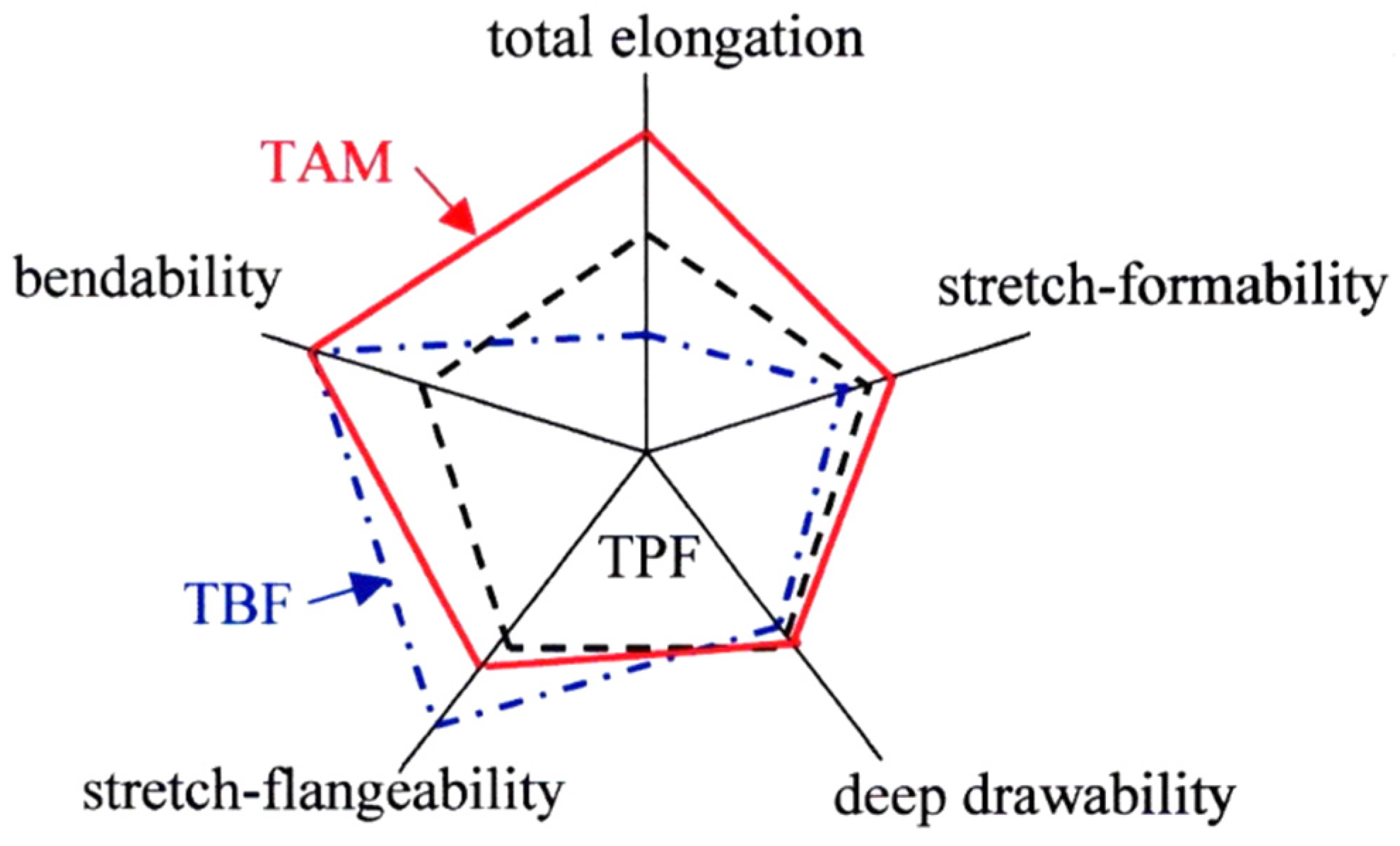

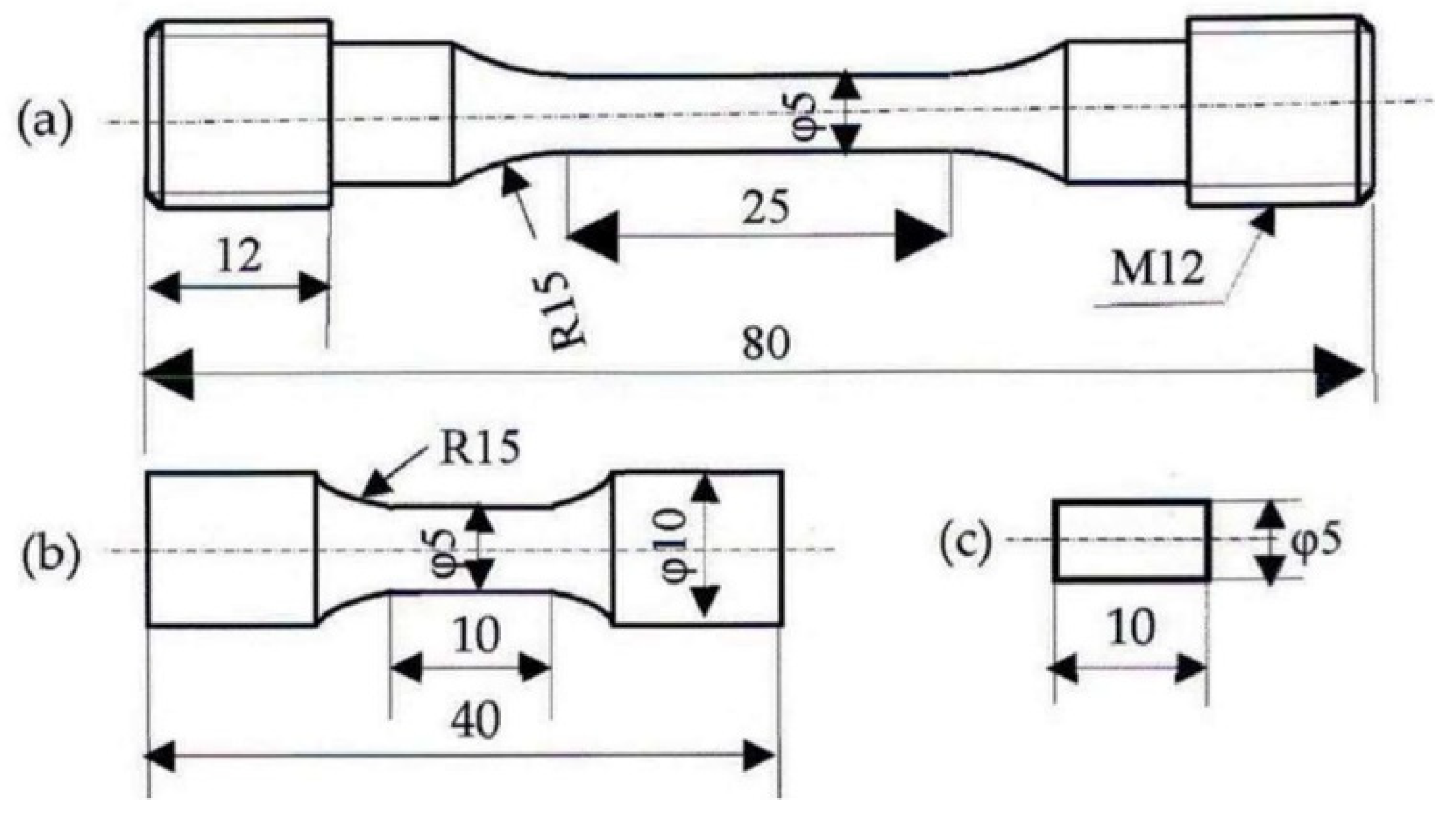
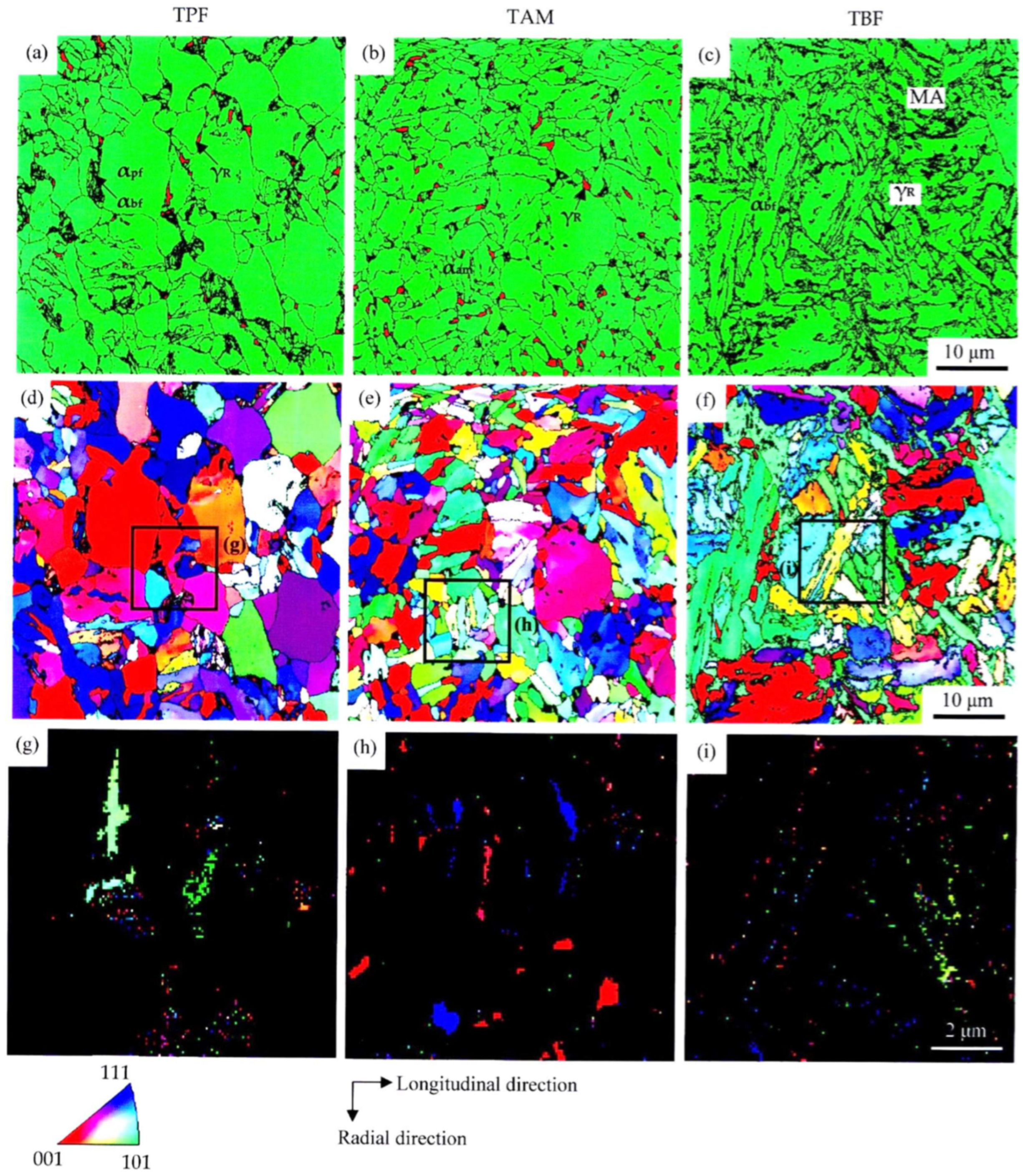





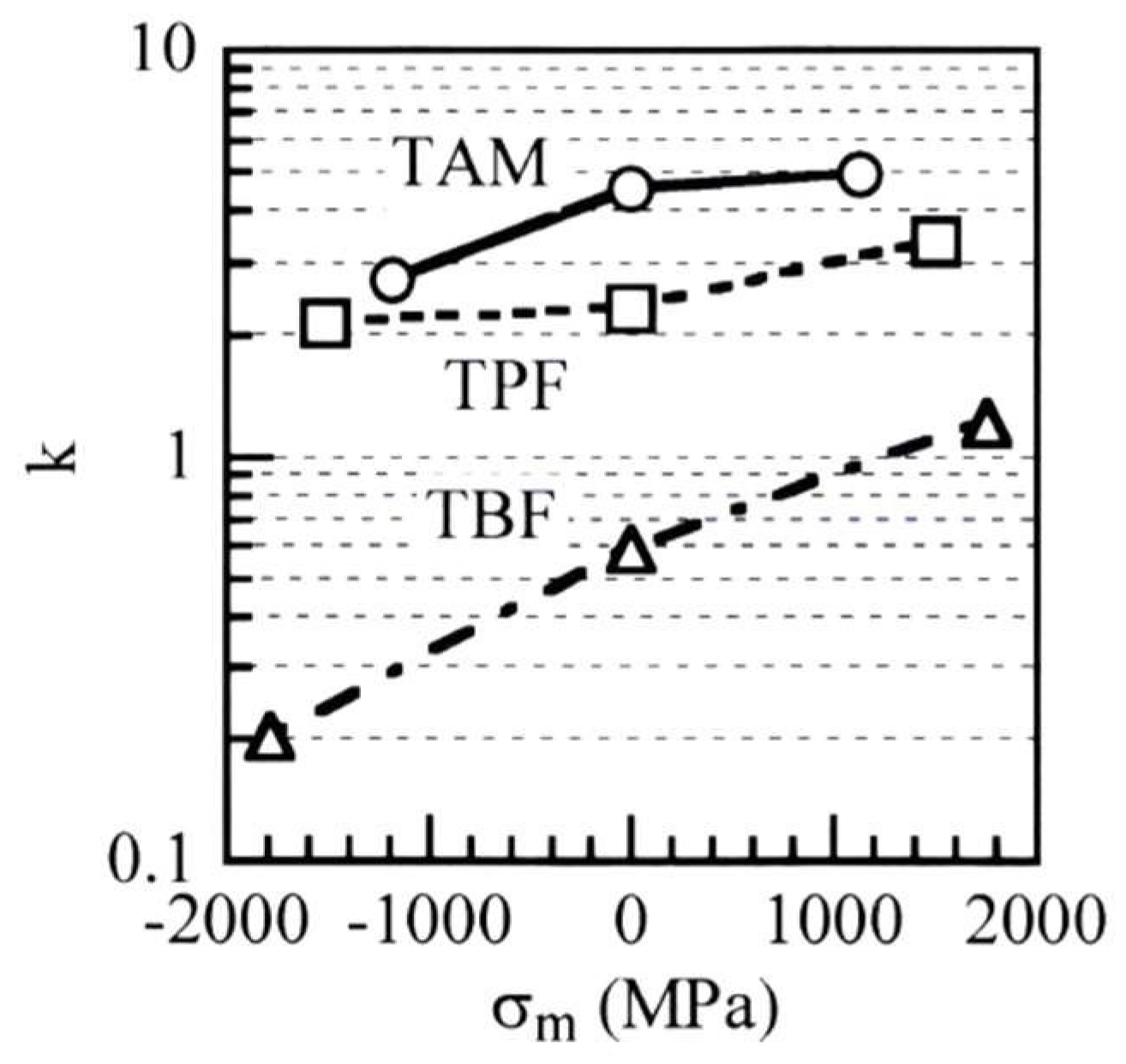

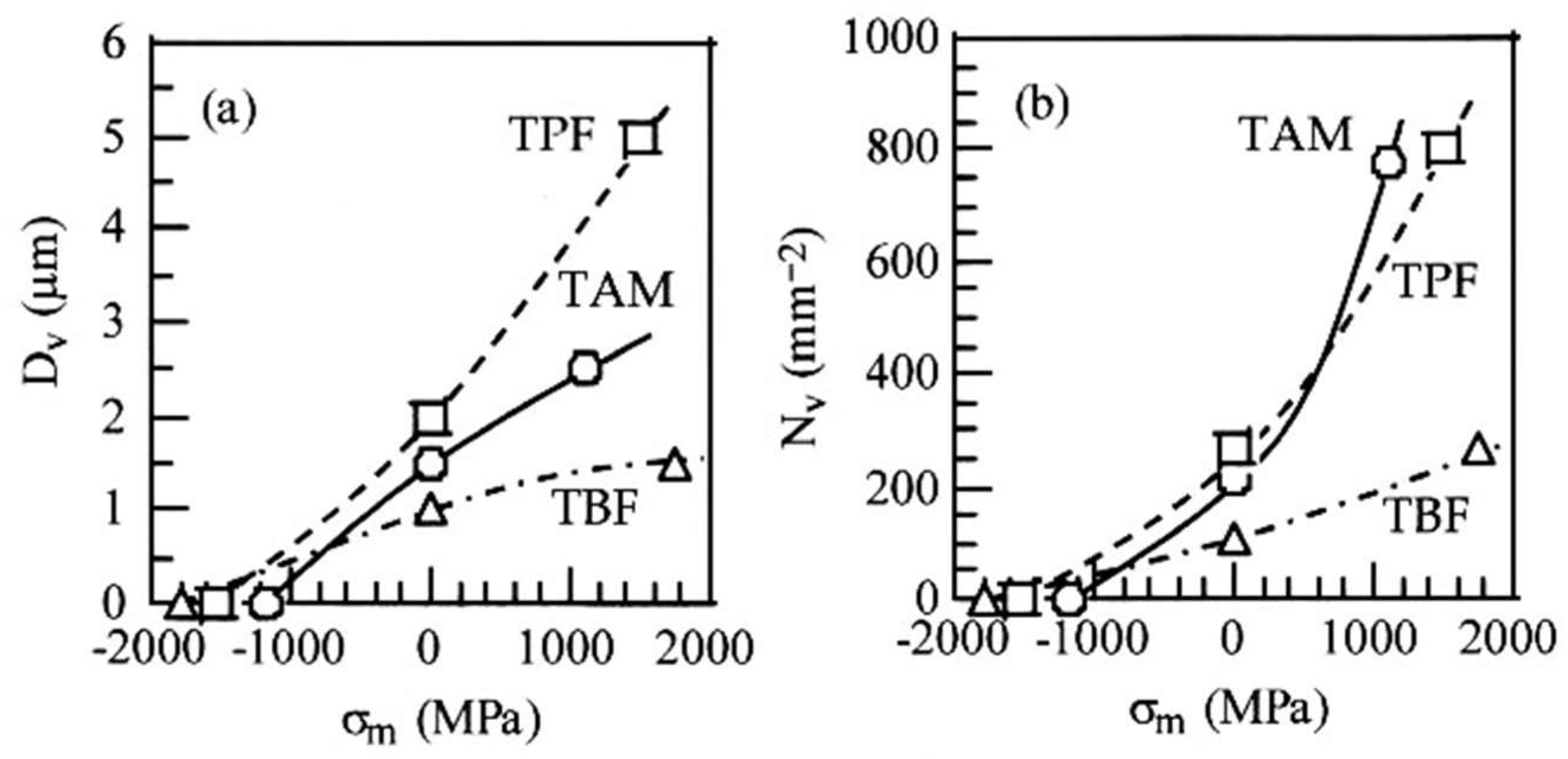

| C | Si | Mn | P | S | Al | Nb | Cr | Mo | N | Ms | Mf |
|---|---|---|---|---|---|---|---|---|---|---|---|
| 0.18 | 1.48 | 1.49 | 0.004 | 0.003 | 0.043 | 0.05 | 1.02 | 0.20 | 0.001 | 407 | 292 |
| Steel | fγ0 (vol.%) | Cγ0 (mass%) | k | fMA (vol.%) | HV0 | ||
|---|---|---|---|---|---|---|---|
| Tension | Torsion | Compression | |||||
| TPF | 8.0 ± 0.6 | 0.51 ± 0.08 | 3.38 | 2.31 | 2.14 | 0 | 329 |
| TAM | 12.4 ± 0.4 | 0.84 ± 0.06 | 4.96 | 4.52 | 2.71 | 0 | 287 |
| TBF | 11.4 ± 1.2 | 0.65 ± 0.14 | 1.21 | 0.59 | 0.20 | 2.0 ± 0.3 | 350 |
| Steel | YS (MPa) | TS (MPa) | UEl (%) | TEl (%) | RA (%) | τ0 (MPa) | τmax (MPa) | σ0 (MPa) |
|---|---|---|---|---|---|---|---|---|
| TPF | 762 | 1098 | 7.3 | 11.6 | 26.6 | 416 | 990 | 695 |
| TAM | 608 | 885 | 11.3 | 19.0 | 52.9 | 383 | 827 | 510 |
| TBF | 709 | 1276 | 9.0 | 17.7 | 49.5 | 613 | 1144 | 737 |
Disclaimer/Publisher’s Note: The statements, opinions and data contained in all publications are solely those of the individual author(s) and contributor(s) and not of MDPI and/or the editor(s). MDPI and/or the editor(s) disclaim responsibility for any injury to people or property resulting from any ideas, methods, instructions or products referred to in the content. |
© 2024 by the authors. Licensee MDPI, Basel, Switzerland. This article is an open access article distributed under the terms and conditions of the Creative Commons Attribution (CC BY) license (https://creativecommons.org/licenses/by/4.0/).
Share and Cite
Sugimoto, K.-i.; Shioiri, S.; Kobayashi, J. Effects of Mean Normal Stress on Strain-Hardening, Strain-Induced Martensite Transformation, and Void-Formation Behaviors in High-Strength TRIP-Aided Steels. Metals 2024, 14, 61. https://doi.org/10.3390/met14010061
Sugimoto K-i, Shioiri S, Kobayashi J. Effects of Mean Normal Stress on Strain-Hardening, Strain-Induced Martensite Transformation, and Void-Formation Behaviors in High-Strength TRIP-Aided Steels. Metals. 2024; 14(1):61. https://doi.org/10.3390/met14010061
Chicago/Turabian StyleSugimoto, Koh-ichi, Shoya Shioiri, and Junya Kobayashi. 2024. "Effects of Mean Normal Stress on Strain-Hardening, Strain-Induced Martensite Transformation, and Void-Formation Behaviors in High-Strength TRIP-Aided Steels" Metals 14, no. 1: 61. https://doi.org/10.3390/met14010061
APA StyleSugimoto, K.-i., Shioiri, S., & Kobayashi, J. (2024). Effects of Mean Normal Stress on Strain-Hardening, Strain-Induced Martensite Transformation, and Void-Formation Behaviors in High-Strength TRIP-Aided Steels. Metals, 14(1), 61. https://doi.org/10.3390/met14010061







